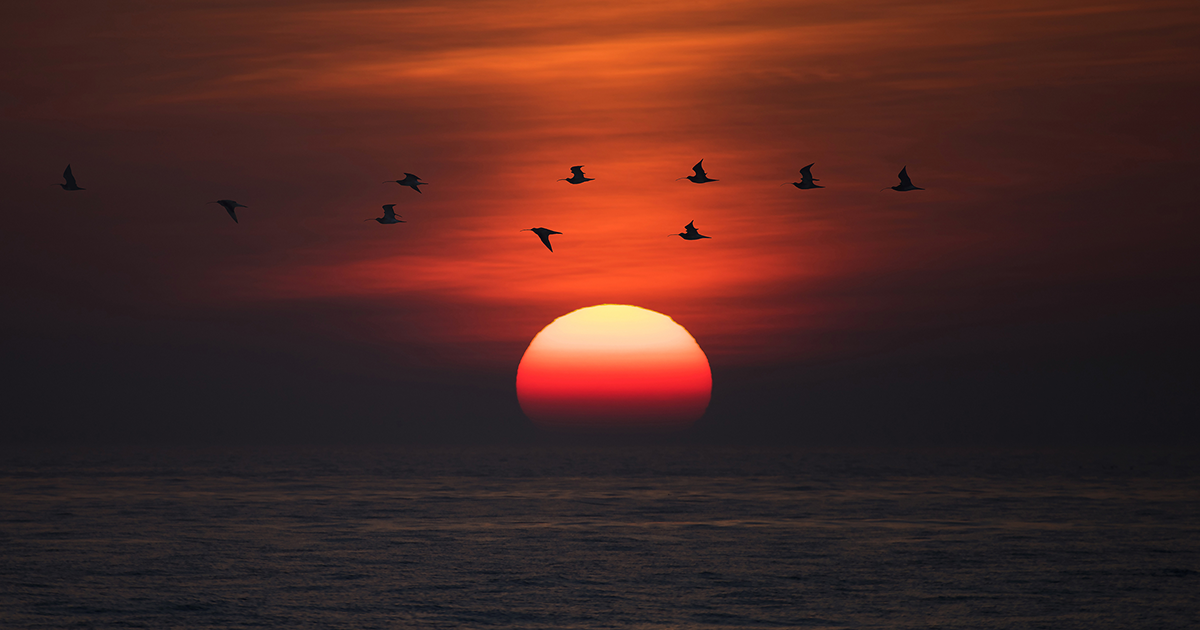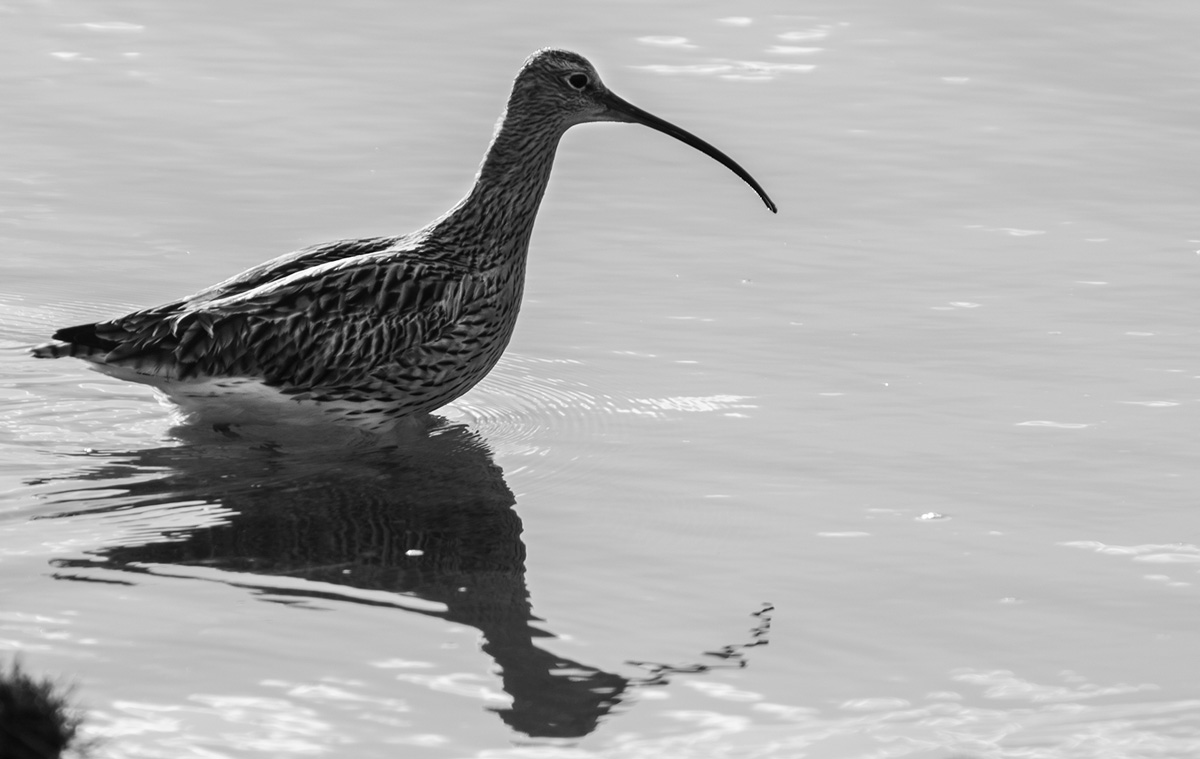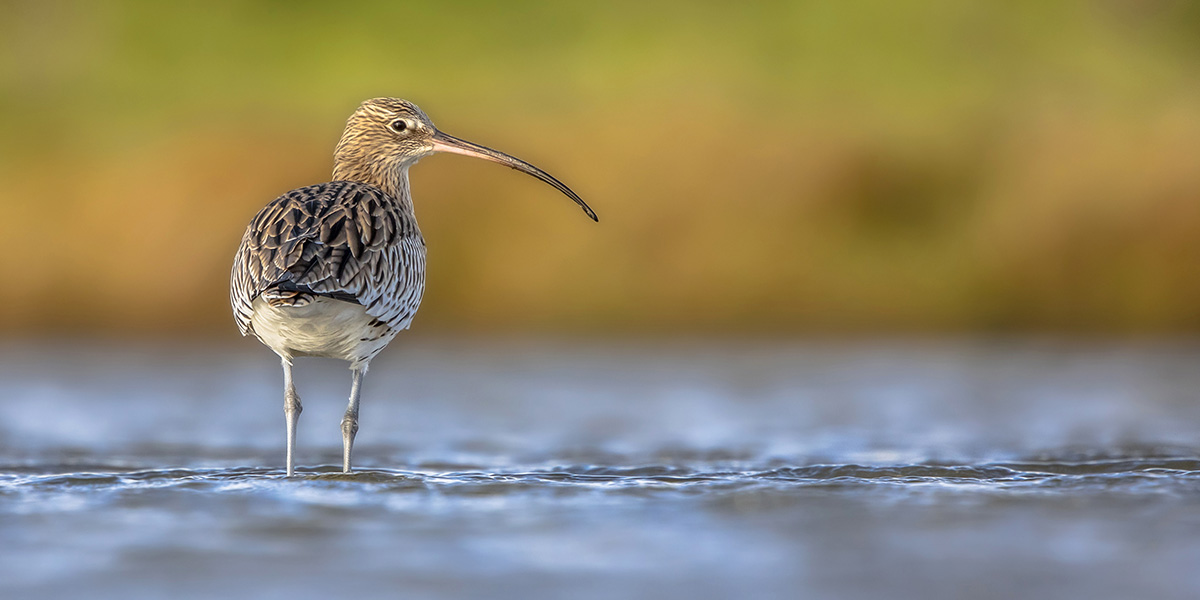28 Nov 2023
Glen Cousquer celebrates the magical call and wonder of this wader, discussing the growing worry of its future in our world.

Image @ FitchyImages / Adobe Stock

Even at a distance, whether stalking the shallows or in flight, the silhouette of the curlew is almost always instantly recognisable. One glance at the gentle sweep of the throat that levels as it meets the beak, before then plunging in a delicate curving line (Figure 1) is enough to commit this profile to memory.
There is, however, a growing concern that this bird may become a bird of memory, consigned to history, a victim of the industrial growth society (Macy and Brown, 2014) that has ravaged our planet. This would be a tragic loss, and in this last of a series of features on the plight of some of the UK’s endangered birds, I focus on this iconic wader and share with you a one health approach to saving the curlew.
The intention here is to introduce readers to the curlew, to the work of deep ecologist Joanna Macy and to one health as a truly transdisciplinary approach that transcends disciplinary silos and seeks to promote ecological health for the environment, other-than-human-animals and humans.

I start with gratitude for this wonder of nature, celebrating some of the attributes that make this bird so remarkable. Gratitude gives way to honouring our pain, however, for I must share with you just how dire things are looking for the curlew. Continuing with the spiral of the work that reconnects (Macy and Brown, 2014), gratitude and grief, give way to seeing with new eyes for we can know more genuinely our relatedness to all that is. We can feel the rich texture of our inter and intra-connections with past and future generations, and with our brother and sister species. Seeing with new eyes arises because we can sense who we really are and feel our own power to change. Finally, we go forth into the actions that call each of us in keeping with our gifts and our calling (Macy and Brown, 2014).
These are the four stages of the “work that reconnects” and I will organise this feature around each of these four stages before explaining how this can inform a one health approach to saving this wonder of creation from extinction.
The name “curlew” – or “courlis” in French – is onomatopoeic, capturing something of the bird’s call, in the same way that the call of the cuckoo and chiffchaff are reflected in their names. Where the curlew is concerned, however, the name only hints at the magical haunting call of these birds and the manner they evoke other-worldly feelings. Scotland’s national bard, Robert Burns, wrote that he had never heard the call “without feeling an elevation of the soul”. More recently, Ted Hughes captured something of their essence, declaiming them as “wet-footed gods of the horizons”, who “in April hang their harps over the misty valleys”.
Anyone who has been lucky enough to spend time attuning to and appreciating the soundscape of our upland areas where curlews breed, or our estuaries where they overwinter, will have an embodied and experiential understanding of how their calls can lift and inspire us. The sound is soulful and touches something beyond words, something deep within us that poets and artists are often best placed to appreciate and evoke. We know we are alive and why we are alive when touched in this way, and we are profoundly grateful to have been awakened from our thoughts. The curlew helps the mind-full become mindful. This can perhaps best be understood as recovering mind’s coherence, which has been defined by Dan Siegel (2022) using the following acronym:
The connection we feel in such wide open soulfully atmospheric places has a harmonious quality to it, for we are synchronising our own energy fields and nervous system with the wider socio-ecological field the curlew haunts. We are then no longer the little I-am, but are in touch with an extended, or ecological, self – we are realising our possibilities and becomings, and are in resonance with the natural world.
John Muir, the father of the National Park movement, grew up on the East Lothian coastline where the images in this article were taken. When he wrote of “the tired, nerve-shaken over-civilised people beginning to find out that … wildness is a necessity”, that visiting these places is a homecoming and that such places are useful “as fountains of life” (Muir, 2019), he is urging us to listen to how such places speak to us, care for us, calm our nervous systems, wake our souls and touch the essence of our being.
It is not too far-fetched to say that such experiences of coherence could, and indeed should, be offered on prescription, for visiting and waking to such places, with their open skies and haunting soundscapes, are healing. We need to seek out and connect with these places (Figures 2a to 2c).
The experiences we have in such environments can reunite us with a naturescape we have spent millennia in and two centuries disconnecting from. They can provide us with an eco-somatic experience that allows us to attune to our inner nature, which all too often we have disconnected from. They can wake us up and, in doing so, alert us to the pandemic of disconnection, or the pandemic of the solo self (Siegel, 2022) that has swept the world. And we can be grateful for waking up, for becoming wake-full, because this allows us to recognise what we have lost, to grieve for it and to honour our pain.
Where once the curlew provided an essential contribution to the orchestral performances that hold up the heavens over estuaries in winter and their upland breeding grounds in summer, there is now no guarantee that our descendants will hear this magic.
The curlew, sadly, is now in peril here in the UK: between 1995 and 2012, the breeding populations declined by 55 per cent in Scotland and 30 per cent in England. In Wales, between 1993 and 2006, a decline of 81 per cent was seen while, in Northern Ireland between 1985-87 and 2013, a decline of 82 per cent has been recorded. This is tragic, given the international importance of the UK breeding population, which makes up between 19 per cent and 27 per cent of the global population.
In 2015, the curlew was added to the UK Red List, following losses of nearly half their breeding numbers over the preceding 20 years, with the British Trust for Ornithology (BTO) launching its curlew appeal (BTO, 2015; 2021).
Bearing witness to this loss and honouring our pain is very different from the shift into problem-solving mode. I therefore invite the reader to pay attention to the curlew and to contemplate the spectre of a Silent Spring (Carson, 1962), devoid of their and other birds’ calls. In addition to listening attentively to their calls, you are invited to imagine (or perhaps watch if you are lucky enough to be able to) them feeding, and to marvel at the pure genius of these birds as they use their bills to probe deep into the mud in search of food (Figure 2).
These birds are part of the genius of these places, for they have evolved in partnership and the intelligence of such life forms is as evolved as our own. To lose this as a result of our mindless plundering and destruction of the natural world will challenge us to find words for the loss, for the apology and healing that must follow if we are to address the moral injuries and trauma that accompany this way of living at war with nature.
Indigenous peoples are leading the way in expressing and articulating this. Maria Yellow Horse Brave Heart defines historical trauma as “cumulative, emotional and psychological wounding over the life span and across generations, emanating from massive group trauma experiences”.
Such trauma is accompanied by a personal and collective sense of unresolved grief. It is sobering to recognise that the imperialist and colonialist project that took slavery, smallpox and forced migrations and cultural extermination of First Nations peoples and Native American tribes is ours to own up to. The emerging field of collective trauma studies is teaching us that our societies are trauma organised and traumatising rather than healing, and that our education systems do not teach us how to move from trauma denial to trauma awareness and then into trauma integration.
Honouring our pain at the enormity of the nature emergency is a crucially important move and one we need to integrate into our education systems so that we are awake to the pain of destroying the same life force (the one source of health and vitality) that flows within each and every one of us.
While there may still be tears in our eyes, honouring our pain allows us to “see through a glass darkly”. We can learn to see and appreciate the true value of the life that the generator of diversity has gifted this planet.
This is the essence of the multi-species justice that the generations inheriting the Earth are seeking as they take our governments to court and challenge them to recognise that our understanding of responsibility has been so ego-centric and anthropocentric that we have created the first civilisation to become a geological force, one whose legacy will be the sixth mass extinction. Part of seeing with new eyes will involve engaging in a sense of wonder that allows us to see more of the whole and appreciate our inter-dependencies. This will allow us to become more creative in our approaches.
Nurturing new possibilities will involve buying into a different imaginary. The three imaginaries that have obsessed veterinary professionals for far too long are the business as usual (same old, same old) imaginary, the techno-fix imaginary that pretends to solve problems at a technical level without recognising the problem statement is incomplete, and the apocalyptic imaginary that leaves us feeling there is little we can do to avert the looming catastrophe. A transformative imaginary, however, opens up the possibility of learning to relate differently at all levels and in seeking relational health in all that we do. Such an approach is trauma informed and open to nurturing response ability.
As veterinary professionals, we can then see beyond the patient and the client, and view the planet as patient. This means a radical shift in how we account for costs, for historically the burden of costs has been shifted to future generations and to the planet. By placing them on the balance sheet and by developing one health approaches that require us to partner and collaborate with other professionals, partners and stakeholders, we can start serving the health of the whole and move away from operating in bubbles.

A one health approach is increasingly transdisciplinary in its approach, integrating contributions from the arts and humanities who are better placed to re-imagine our humanity, and how we can move from the domination system to the partnering system. This will not be easy for veterinary professionals who are not used to surrendering control and partnering in such radically open ways. We can start small, perhaps by seeking out opportunities to contribute to curlew conservation. It may sound strange as a starting point, but there is now a curlew ringtone for phones that can work as a great conservation starter (see The Curlew Sounds Project).
Opportunities are also available to contribute to surveying curlew breeding areas, which help us to dial into the realities curlews face on a particular patch. The importance of showing an interest and caring enough to share that interest with others is easy to underestimate. We can also promote awareness of “green prescribing” and encourage people to seek out such prescriptions from their GPs.
We may choose to embrace the challenge of supporting small-scale regenerative farming and in integrating our work with ecological insights into how to promote biodiversity on farmlands. Curlews will thank you for this because their needs in terms of shelter and food will be better met throughout the seasons. Those of us taking care of livestock used for conservation grazing will ensure that they do not go on to nature reserves with drug residues that can affect invertebrates and other life forms. Other areas where vets can make a significant contribution include promoting leave-no-trace education and responsible dog ownership. This includes ensuring dog owners understand how vulnerable ground nesting birds are to disturbance and the impact of allowing a recently treated dog to enter watercourses.
These are just a few examples of things we could explore to help save the curlew.
This piece has explored our deeper connections with the curlew and provided insights into the unresolved grief that arises when we lose part of the fabric of the ecosystem. It has also highlighted the need to think more ecologically and to partner with other stakeholders in developing health care strategies.
Such approaches are rooted in one health principles, for they recognise the interconnections between environmental health and the health of humans and other-than-human animals, as well as the need to develop transdisciplinary approaches that allow us to transcend the anthropocentric business as usual, and techno-fix approaches that fail to address the fundamental cause of the crises we face – our failures to understand ourselves as inextricably connected to and dependent on nature.
Glen Cousquer
Job Title